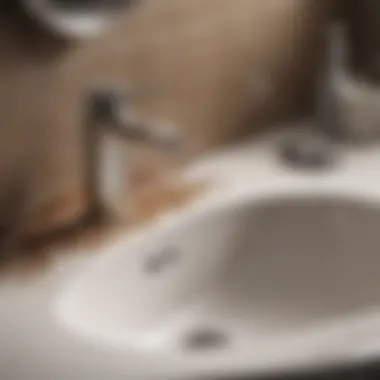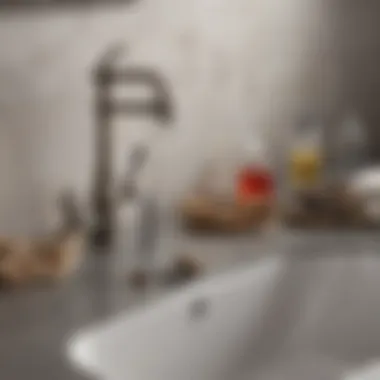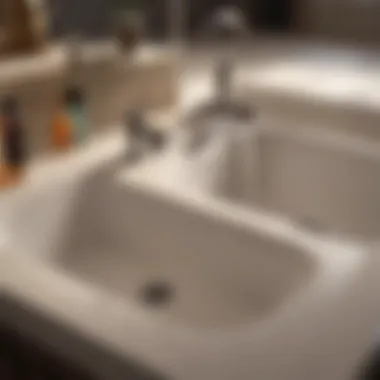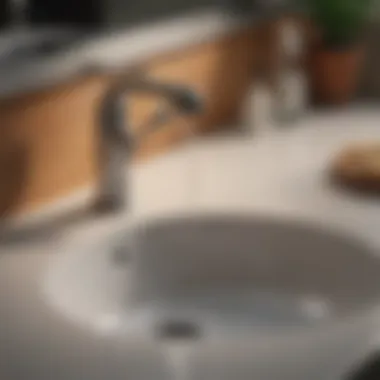Clearing Clogs: How to Clean Your Bathroom Sink


Intro
Cleaning a clogged bathroom sink can be an unpleasant and inconvenient task. However, understanding the underlying causes of clogs and knowing the right methods and tools can make this process simpler and more effective. This guide aims to equip homeowners with knowledge about various cleaning methods, preventative measures, and essential tools needed to tackle the problem with confidence.
A clogged sink is often a sign of larger plumbing issues, but it can usually be resolved without professional help. With preparation and the right approach, homeowners can maintain their sinks effectively and avoid recurring issues. From hair and soap scum to foreign objects, several factors lead to clogs in bathroom sinks. Understanding these is crucial in addressing the problem.
The subsequent sections will detail step-by-step cleaning techniques, common materials involved in plumbing, and practical advice to ensure long-lasting solutions. Whether you are dealing with a minor obstruction or a more significant blockage, this guidance aims to address both the immediate and future maintenance needs of your bathroom sink.
Understanding Clogged Bathroom Sinks
Understanding the nature of clogged bathroom sinks is fundamental for effective home maintenance. Clogs can disrupt daily routines and lead to larger plumbing issues if not addressed promptly. This section delves into various elements that cause clogs and the signs they exhibit, providing clarity on maintaining a functional sink. Recognizing the underlying causes helps in choosing the right approach to clear the blockage, thus saving time and preventing potential expenses.
Common Causes of Clogs
Hair buildup
Hair buildup is one of the most common culprits of bathroom sink clogs. Over time, strands of hair collect in the drain, forming a mass that traps soap, dirt, and other materials. This accumulation often leads to significant blockages. One key characteristic of hair buildup is its ability to bind with other residues, creating a stubborn obstruction. Addressing this issue is valuable in this article, as it highlights the necessity for regular cleaning to prevent future blockages. The unique feature of hair buildup is its tendency to be overlooked until it causes a major issue, requiring homeowners to be proactive in their maintenance approaches.
Soap residue
Soap residue contributes greatly to clogs due to its sticky nature. As soap dissolves in water, it can leave a film on the drain's interior, which, when combined with other debris, creates an obstruction. The key characteristic of soap residue is that it often builds up slowly, making it easy to ignore until significant drainage problems occur. In this article, its analysis is beneficial because it underscores the importance of using quality soaps and regular cleaning methods to minimize residue build-up and ensure smooth drainage. Its unique feature lies in the fact that it can lead to unpleasant odors in addition to clogs, thus amplifying its impact on overall sink hygiene.
Mineral deposits
Mineral deposits often arise from hard water, a common issue in many homes. These deposits can form over time, gradually narrowing the pipe's capacity and leading to clogs. A notable aspect of mineral deposits is their persistence; they do not dissolve easily and can require significant effort to eliminate. This article benefits from highlighting mineral deposits, as understanding their formation helps homeowners select appropriate cleaning methods. The unique feature of mineral deposits is that they often need chemical solutions to clear effectively, presenting an additional challenge for those aiming for a more natural cleaning approach.
Foreign objects
Foreign objects can easily slip into the sink, especially in bathrooms where various items are used. Items like toothpaste caps, plastic wrappers, or even makeup tools can obstruct the drain. A critical characteristic of foreign objects is their unpredictability; knowing what might inadvertently fall into the sink can be challenging. This article finds value in addressing foreign objects because it emphasizes being mindful during activities around the sink to prevent clogs. Unique to this cause is the immediate need for manual retrieval, which can either be straightforward or complicated depending on the item lodged within the system.
Signs of a Clogged Sink
Slow drainage
Slow drainage is one of the first indicators of a clogged sink. This occurs when debris accumulates within the pipes, causing water to drain more slowly than usual. The key characteristic of slow drainage is its immediate impact on daily activities, as it forces one to reconsider how and when to use the sink. This article places importance on recognizing slow drainage because it serves as an early warning sign of a potential blockage. The unique feature of slow drainage is that it often escalates if not addressed promptly, eventually leading to complete clogs.
Unpleasant odors
Unpleasant odors emerging from a sink can signal that something is amiss. These odors often develop due to decomposing organic materials caught in a clog. A notable characteristic of unpleasant odors is their ability to make a bathroom space feel uninviting. Recognizing these odors is essential in this article, as they serve as another warning sign of a clogged sink that requires immediate attention. The unique aspect of unpleasant odors is their emotional impact; they often lead to a sense of urgency to rectify the problem due to hygiene concerns.
Frequent backups
Frequent backups can significantly disrupt daily life. This issue occurs when water does not drain correctly, often spilling back into the sink during use. One key characteristic of frequent backups is the visibility of a problem, making it hard to ignore. Emphasizing this point in the article serves to inform homeowners about the need for prompt action upon experiencing backups. The unique feature of frequent backups is that they may reveal more severe plumbing issues, reinforcing the need for investigation beyond the immediate symptom.
Tools and Materials Required
Effective cleaning of a clogged bathroom sink necessitates the right tools and materials. They not only streamline the process but also enhance the likelihood of a successful unclogging. Understanding which tools are essential and the products to use provides homeowners with confidence and efficiency in tackling some common plumbing issues.


Essential Tools
Plunger
The plunger is often the first tool that comes to mind when addressing a clogged sink. Its role in loosening blockages cannot be overstated. A good-quality plunger typically features a rubber suction cup that creates a seal around the drain. This seal allows the user to generate sufficient pressure through pushing and pulling motions.
The main benefit of a plunger is its simplicity. It does not rely on any chemicals or electricity, making it an eco-friendly option. However, it requires physical effort and may not work on more severe clogs that a simple push cannot break. The key is to ensure that the cup covers the drain and to use quick, forceful thrusts for the best results.
Drain snake
Moving to a more specialized tool, the drain snake serves as a reliable solution for deeper clogs. Essentially, it consists of a flexible, coiled metal wire that can reach further down the pipes. Its primary function is to snag and pull out debris that might be obstructing the flow of water.
This tool is particularly advantageous because it reaches areas that a plunger cannot access. Using a drain snake requires a bit of skill; it is essential to steer it carefully to avoid damage to the pipes. A major consideration is its manual effort. However, many find it satisfactory and effective in resolving issues associated with hair buildup or other stubborn clogs.
Wrench
The wrench, while not directly associated with unblocking sinks, plays a strategic role particularly in dealing with plumbing fittings. When removing a sink trap or any part of the plumbing assembly, a wrench can provide significant leverage.
Its key characteristic lies in its adjustable grip, allowing users to handle various sizes of fittings without needing multiple tools. While using a wrench may not be necessary for all clogs, it becomes crucial when addressing more complex plumbing issues or when a pipe needs to be tightened or loosened. Conversely, improper use can lead to damage, making it essential for users to ensure a snug fit without over-tightening.
Cleaning Solutions
Vinegar and baking soda
Moving past physical tools, vinegar and baking soda represent a natural alternative for cleaning drains. This combination creates a chemical reaction that can help break down certain types of debris. It is particularly effective for softening soap scum and dissolving minor clogs.
The primary advantage of using vinegar and baking soda is their non-toxic nature. Homeowners can utilize these ingredients without worrying about potential damage to the environment or their plumbing systems. The reaction that occurs is safe and efficient, but its effectiveness decreases with severe clogs; more stubborn blockages might require stronger methods.
Commercial drain cleaners
For more severe clogs, commercial drain cleaners are often a go-to solution. These products are designed specifically for plumbing issues and can dissolve a wide variety of materials that cause blockages. The primary feature here is their potent chemical formulation, designed for quick and effective action.
However, one must be cautious when using these products. While commercial cleaners can yield rapid results, they may pose risks to pipe integrity over time. Extended use might lead to corrosion, which can result in leaks or further plumbing issues down the line.
Boiling water
Finally, boiling water can serve as an effective quick fix for minor clogs, especially those caused by soap residue or grease build-up. The heat helps dissolve materials that obstruct the flow, restoring drainage.
It is an accessible solution, requiring only water and a heat source. Though boiling water may not work on all clogs, it is a safe and straightforward approach worthy of consideration. However, its effectiveness diminishes with more determined blockages. When attempting to rectify a major clog, boiling water should be viewed as complementary to other methods rather than a standalone solution.
Preliminary Steps Before Cleaning
Before embarking on the task of cleaning a clogged bathroom sink, it is essential to conduct preliminary steps to facilitate a smoother process. These steps are not merely formalities; they lay the foundation for effective cleaning and can significantly aid in preventing further issues. By understanding the importance of both assessing the damage and preparing the area, you can enhance your cleaning efforts and maintain a functional sink in the long run.
Assessing the Damage
Visual inspection
A visual inspection provides crucial insights into the condition of the sink and its plumbing. This step involves looking for obvious blockages, such as standing water or debris accumulation in the sink and drain. By observing these indicators, one can determine if the clog is superficial or more serious, ensuring appropriate actions are taken.


The key characteristic of a visual inspection is its simplicity and non-invasiveness. It does not require any specialized tools, making it accessible to homeowners. When inspecting, check for any changes in the sink or plumbing condition, such as discoloration or corrosion, which may indicate larger issues. However, a disadvantage of relying solely on visual inspection is that it may not reveal issues deep within the plumbing system, which could require further investigation.
Understanding the plumbing layout
Understanding the plumbing layout is another vital step. Knowing how your sink, traps, and drainage systems connect can help you identify possible causes of the clog and choose the right cleaning methods. This knowledge is especially beneficial when addressing recurring clogs, as it may reveal underlying plumbing issues or improper installations.
The significant characteristic of understanding the plumbing layout is that it empowers homeowners with knowledge. It allows for informed decisions on which cleaning tools to use—be it a plunger or a snake. However, an extensive plumbing layout might overwhelm some. If you're not familiar with your system, it may necessitate further research or consultation with professionals, which could introduce added steps in the process.
Preparing the Area
Clearing the sink
Clearing the sink is essential before initiating any cleaning efforts. This step involves removing any items from the countertop and inside the sink to access the drain freely. An uncluttered area allows a more efficient cleaning process and decreases the chances of materials becoming further lodged in the drain.
A key advantage of clearing the sink is the prevention of further mess. It minimizes potential spills or accidents while cleaning. While clearing might seem straightforward, it is often overlooked, leading to distractions during the cleaning act. Neglecting this step could result in damaging items or creating a disorderly situation.
Protecting surfaces
Protecting surfaces around the sink is another important action that should not be overlooked. Placing towels or plastic sheets can help avoid damage from splashes or spills during the cleaning process. This step safeguards your countertop and any fixtures from potentially harmful chemicals or tools.
A key characteristic of protecting surfaces is that it emphasizes caution. It demonstrates foresight in maintaining the aesthetics of your bathroom. However, this process can add time to your preparation. If you are under a tight schedule, you may under-prioritize this step, but investing that time pays off by preventing unnecessary clean-up or repairs later.
Step-by-Step Cleaning Process
Cleaning a clogged bathroom sink demands a systematic approach to be effective. A clear step-by-step cleaning process not only helps in efficiently removing the clog but also minimizes the risk of damage to your plumbing. Addressing clogs in this organized manner leads to successful outcomes and reduces the chances of recurrence.
Using a Plunger
Proper technique
To effectively use a plunger, proper technique is crucial. The primary aspect involves creating a strong seal around the drain, ensuring no air escapes during the process. The ideal characteristic of this technique is establishing effective pressure. This pressure forces the blockage to break apart and move down the pipe. A significant advantage of using a plunger is its simplicity; it requires no special tools or chemicals. However, it might not be effective for stubborn clogs, which could need further methods.
Tips for effectiveness
To maximize the effectiveness of plunging, several tips are valuable. Key among these is using enough water to cover the plunger’s cup. This ensures a complete seal is achieved. Another characteristic is that maintaining a steady and rhythmic motion enhances the clearing action. This method is beneficial as it often avoids harmful chemicals. A unique feature is its low cost. However, if the clog persists after several attempts, it may indicate a deeper issue.
Employing a Drain Snake
How to use a drain snake
Using a drain snake effectively requires understanding its operation. The primary aspect involves inserting the snake into the drain and rotating it to navigate bends in the pipes. This characteristic allows it to reach deeper blockages. The beauty of the drain snake is in its ability to reach clogs beyond the reach of other tools. However, some may find it cumbersome to handle, especially for those unfamiliar with its use. Yet, it presents a reliable alternative when simpler methods fail.
Safety precautions
Safety precautions are essential when using a drain snake. The most critical aspect is wearing gloves to protect your hands from debris and potential contaminants. A key characteristic is ensuring that the plumbing is intact before inserting the snake, as applying too much force can cause pipe damage. This approach is prudent because it prevents larger issues. While the drain snake is effective, it does require careful handling to avoid injury or plumbing accidents.
Chemical Solutions


Application process
The application process for chemical solutions is straightforward but needs caution. The essential aspect is to follow instructions carefully to avoid harmful reactions. A key characteristic of this method is quick action; chemical solutions can dissolve clogs rapidly. Its unique feature is that, when used correctly, it can resolve blockages without mechanical intervention. However, misuse can lead to severe damage, and thus, all safety instructions must be read.
Environmental considerations
Environmental considerations are increasingly important in choosing chemical solutions. The aspect to note is the potential impact of harsh chemicals on water systems and human health. Choosing biodegradable options is recommended, as they offer a more eco-friendly choice. This characteristic appeals to those concerned about sustainability. While chemical solutions can be effective, the unique feature of their environmental impact makes it necessary to weigh options carefully. Focusing on safer alternatives can result in more responsible cleaning methods.
Post-Cleaning Maintenance
Post-cleaning maintenance is a critical component in ensuring that a bathroom sink remains functional after addressing a clog. Many individuals may feel a sense of accomplishment after successfully unclogging their sink, but without proper care, the issue can quickly recur. By focusing on post-cleaning activities, homeowners can not only prolong the life of their plumbing fixtures but also enhance the overall hygiene and efficiency of their bathroom.
Testing Drainage
Assessing Effectiveness
Assessing the effectiveness of the cleaning process is essential. This involves checking how well the sink drains after the cleaning methods have been employed. A simple test is to run water through the sink and observe the flow. If the water drains freely, it indicates a successful unclogging, which contributes to maintaining a clean and functional sink. The key characteristic of this process lies in its simplicity; it requires no special tools or expertise, making it accessible to most homeowners. Additionally, reassessing drainage helps identify any underlying issues that might need immediate attention, reducing the risk of further problems.
"Regular testing of drainage after cleaning can save time and money by preventing major clogs in the future."
Identifying Residual Issues
Identifying residual issues is crucial in post-cleaning maintenance. After the initial cleaning, it is important to determine if any remnants of the clog remain. This could manifest as slow drainage or occasional blockages. The key here is vigilance. Homeowners should keep a close eye on their sinks in the days following a cleaning. Detecting issues early allows for prompt intervention, which can save costly repairs later. The unique feature of identifying residual issues is that it serves as an ongoing monitoring process, leading to long-term solutions rather than temporary fixes.
Preventative Measures
Preventative measures are vital for ensuring that clogs do not recur after cleaning. Implementing routine practices can significantly extend the lifespan of a sink and mitigate future problems.
Routine Cleaning Tips
Routine cleaning tips form the backbone of effective home maintenance. Regularly cleaning the sink and removing debris, such as hair and soap residue, can prevent clogs from developing. The key characteristic of these tips is their simplicity; common items like vinegar or baking soda can be used, making this an economical choice for homeowners. Regular upkeep not only keeps the sink clear but also enhances the overall appearance of the bathroom. Proactive maintenance strategies eliminate the need for extensive repairs in the future.
Proper Disposal of Materials
Proper disposal of materials is another essential factor in maintaining unclogged sinks. Items like wipes, cotton swabs, and excessive food particles should never be flushed down the drain. This is a fundamental practice that many overlook. Educating all household members on what can safely go down the sink is beneficial. The unique feature of this preventative measure is its simplicity: a few guidelines can effectively minimize the risk of clogs. However, it requires consistent effort and communication within the household.
In summary, the importance of post-cleaning maintenance cannot be overstated. By taking the time to assess drainage, identify residual issues, and implement preventative measures, homeowners can ensure their bathroom sinks remain functional and clog-free.
Epilogue
Cleaning a clogged bathroom sink is a topic of significant relevance for homeowners seeking to maintain their home efficiently. Understanding the methods of unclogging can save time, energy, and money. This process not only improves drainage but also extends the life of plumbing systems.
Summary of Key Steps
To effectively tackle a clogged sink, it is essential to follow a systematic approach. Initially, identifying the cause of the clog lays the foundation for effective resolution. Common methods include using a plunger, a drain snake, or chemical solutions. After the cleaning, testing the effectiveness of drainage ensures the problem is fully addressed. Adopting preventative measures can help in avoiding future clogs.
Final Recommendations
Regular maintenance strategies
Regular maintenance is a vital aspect of keeping your bathroom sink functioning optimally. Engaging in routine inspections can reveal potential issues before they become significant problems. Regular cleaning of the sink and drain can remove buildup caused by hair and soap residue. This proactive approach contributes to longer-lasting plumbing systems. One key characteristic of regular maintenance is the simple yet effective solutions involved, making it a popular choice among homeowners. However, some may find it tedious; therefore, creating a schedule can facilitate this practice.
Professional help considerations
In some cases, seeking professional help is a crucial step in addressing plumbing issues. Not all clogs are easily resolved, and persistent problems may indicate deeper plumbing concerns. A key characteristic of hiring professionals is their expertise and access to specialized tools, which can significantly improve cleaning results. Professional intervention is often a beneficial choice, as it assures proper and complete unclogging. Nevertheless, this option can be more expensive than DIY methods. Weighing the cost against the potential for damage or further complications is essential for determining the proper course of action.



